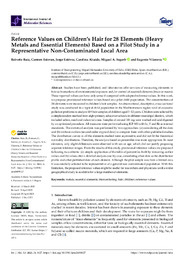Título :
Reference Values on Children’s Hair for 28 Elements (Heavy Metals and Essential Elements) Based on a Pilot Study in a Representative Non-Contaminated Local Area |
Autor :
Ruiz, Roberto
Estevan, Carmen
Jorge, Estévez 
Alcaide, Carolina
SOGORB, MIGUEL A 
Vilanova, Eugenio |
Editor :
MDPI |
Departamento:
Departamentos de la UMH::Biología Aplicada |
Fecha de publicación:
2023-04-25 |
URI :
https://hdl.handle.net/11000/30719 |
Resumen :
Studies have been published, and laboratories offer services of measuring elements in hair as biomarkers of environmental exposure and/or control of essential elements (trace or macro). These reported values can have only sense if compared with adopted reference values. In this work, we propose provisional reference values based on a pilot child population. The concentrations of 28 elements were measured in children’s hair samples. An observational, descriptive, cross-sectional study was conducted in a typical child population in the Mediterranean region void of excessive pollution problems to analyze 419 hair samples of children aged 3–12 years. Children were selected by a simple random method from eight primary education schools in different municipal districts, which included urban, rural and industrial areas. Samples of around 100 mg were washed and acid digested by an optimized procedure. All measures were performed using ICP-MS with Sc, Y and Re as internal standards. The statistical analysis was performed by two approaches: (a) considering all the data and (b) without outliers (second-order atypical data) to compare them with other published studies. The distribution curves in all the elements studied were asymmetric and did not fit the theoretical normality distributions. Therefore, the analysis based on percentiles was more appropriate. In most elements, only slight differences were observed with sex or age, which did not justify proposing separate reference ranges. From the results of this study, provisional reference values are proposed following two criteria: (a) simple application of the table of percentiles built by removing outlier values and (b) values after a detailed analysis case-by-case, considering other data as the distribution profile and other published data of each element. Although the pilot sample was from a limited area, it was carefully selected to be representative of a general non-contaminated population. With this limitation, the proposed reference values might be useful for researchers and physicians until a wider geographical study is available for a large number of elements.
|
Palabras clave/Materias:
metals
essential elements
biomonitoring
hair
children
reference values |
Área de conocimiento :
CDU: Ciencias puras y naturales: Biología |
Tipo documento :
application/pdf |
Derechos de acceso:
info:eu-repo/semantics/openAccess
Attribution-NonCommercial-NoDerivatives 4.0 Internacional |
DOI :
https://doi.org/10.3390/ijms24098127 |
Aparece en las colecciones:
Artículos Biología Aplicada
|
 La licencia se describe como: Atribución-NonComercial-NoDerivada 4.0 Internacional.
La licencia se describe como: Atribución-NonComercial-NoDerivada 4.0 Internacional.
.png)
